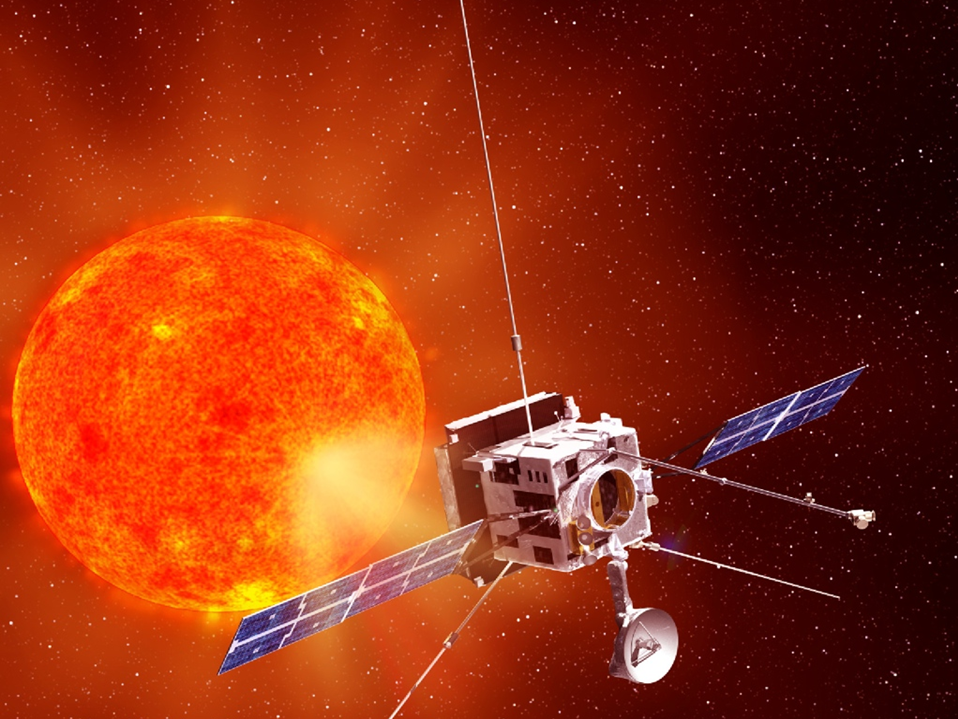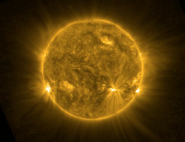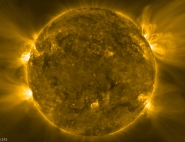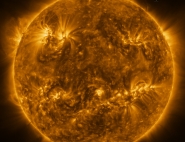Satellite
Solar Orbiter is a specially designed three-axis stabilized spacecraft. To cope with the extreme Solar radiation at perihelion, a sunshield, always pointing to the Sun, protects the spacecraft and provides openings to let the instruments peek at the Sun. The spacecraft provides a thermally stable environment and a stable pointing to the instruments on board. Solar Orbiter will exploit new technologies being developed by ESA for the BepiColombo mission to Mercury, the closest planet to the Sun.

Solar Orbiter's payload comprises a powerful combination of 10 in-situ and remote-sensing instruments, designed to answer several of the outstanding, fundamental questions in solar and heliophysics today.
![]()
![]()
![]()
Instruments location on the satellite
Heliospheric In-Situ Instruments
 SWA (Solar Wind Analyzer), Principal Investigator: Dr Christopher Owen, Mullard Space Science Laboratory, United Kingdom. SWA consists of a suite of sensors that will measure the density, velocity, and temperature of solar wind ions and electrons, thereby characterizing the solar wind between 0.28 and 1.4 AU from the Sun. In addition to determining the bulk properties of the wind, SWA will provide measurements of solar wind ion composition for key elements (e.g. the C, N, O group and Fe, Si or Mg).
SWA (Solar Wind Analyzer), Principal Investigator: Dr Christopher Owen, Mullard Space Science Laboratory, United Kingdom. SWA consists of a suite of sensors that will measure the density, velocity, and temperature of solar wind ions and electrons, thereby characterizing the solar wind between 0.28 and 1.4 AU from the Sun. In addition to determining the bulk properties of the wind, SWA will provide measurements of solar wind ion composition for key elements (e.g. the C, N, O group and Fe, Si or Mg). EPD (Energetic Particle Detector), Principal Investigator: Dr Javier Rodríguez-Pacheco, University of Alcala, Spain. EPD will measure the properties of suprathermal and energetic particles.
EPD (Energetic Particle Detector), Principal Investigator: Dr Javier Rodríguez-Pacheco, University of Alcala, Spain. EPD will measure the properties of suprathermal and energetic particles. MAG (Magnetometer), Principal Investigator: Dr Tim Horbury, Imperial College London, United Kingdom. The magnetometer will provide in-situ measurements of the heliospheric magnetic field. This will facilitate detailed studies into the way the Sun's magnetic field links into space and evolves over the solar cycle; how particles are accelerated and propagate around the solar system, including to the Earth; how the corona and solar wind are heated and accelerated.
MAG (Magnetometer), Principal Investigator: Dr Tim Horbury, Imperial College London, United Kingdom. The magnetometer will provide in-situ measurements of the heliospheric magnetic field. This will facilitate detailed studies into the way the Sun's magnetic field links into space and evolves over the solar cycle; how particles are accelerated and propagate around the solar system, including to the Earth; how the corona and solar wind are heated and accelerated. RPW (Radio and Plasma Wave analyzer), Principal Investigator: Dr Milan Maksimovic, LESIA, Observatoire de Paris, France. The RPW experiment is unique amongst the Solar Orbiter instruments in that it makes both in-situ and remote-sensing measurements. RPW will measure magnetic and electric fields at high time resolution using a number of sensors/antennas, to determine the characteristics of electromagnetic and electrostatic waves in the solar wind.
RPW (Radio and Plasma Wave analyzer), Principal Investigator: Dr Milan Maksimovic, LESIA, Observatoire de Paris, France. The RPW experiment is unique amongst the Solar Orbiter instruments in that it makes both in-situ and remote-sensing measurements. RPW will measure magnetic and electric fields at high time resolution using a number of sensors/antennas, to determine the characteristics of electromagnetic and electrostatic waves in the solar wind.
Solar Remote-Sensing Instruments
 SO/PHI (Polarimetric and Helioseismic Imager), Principal Investigator: Dr Sami Solanki, Max-Planck-Institut für Sonnensystemforschung, Germany. SO/PHI, will provide high-resolution and full-disk measurements of the photospheric vector magnetic field and line-of-sight (LOS) velocity as well as the continuum intensity in the visible wavelength range. The LOS velocity maps will have the accuracy and stability to allow detailed helioseismic investigations of the solar interior, in particular of the solar convection zone.
SO/PHI (Polarimetric and Helioseismic Imager), Principal Investigator: Dr Sami Solanki, Max-Planck-Institut für Sonnensystemforschung, Germany. SO/PHI, will provide high-resolution and full-disk measurements of the photospheric vector magnetic field and line-of-sight (LOS) velocity as well as the continuum intensity in the visible wavelength range. The LOS velocity maps will have the accuracy and stability to allow detailed helioseismic investigations of the solar interior, in particular of the solar convection zone. EUI (EUV full-Sun and high-resolution Imager), Principal Investigator: Dr Pierre Rochus, CSL, Belgium. EUI will provide image sequences of the solar atmospheric layers above the photosphere, thereby providing an indispensable link between the solar surface and outer corona that ultimately shapes the characteristics of the interplanetary medium. EUI will also provide the first-ever images of the Sun from an out-of-ecliptic viewpoint (up to 34° of solar latitude during the extended mission phase).
EUI (EUV full-Sun and high-resolution Imager), Principal Investigator: Dr Pierre Rochus, CSL, Belgium. EUI will provide image sequences of the solar atmospheric layers above the photosphere, thereby providing an indispensable link between the solar surface and outer corona that ultimately shapes the characteristics of the interplanetary medium. EUI will also provide the first-ever images of the Sun from an out-of-ecliptic viewpoint (up to 34° of solar latitude during the extended mission phase). SPICE (EUV spectral Imager), Principal Investigator: Dr Don Hassler, Southwest Research Institute, Boulder, USA. This instrument will provide an extreme ultraviolet spectrometer or optical instrument that will measure different wavelengths of light emitted from the sun.
SPICE (EUV spectral Imager), Principal Investigator: Dr Don Hassler, Southwest Research Institute, Boulder, USA. This instrument will provide an extreme ultraviolet spectrometer or optical instrument that will measure different wavelengths of light emitted from the sun. STIX (X-ray spectrometer/telescope), Principal Investigator: Dr Arnold O. Benz, Institute of Astronomy, ETH Zurich, Switzerland. STIX provides imaging spectroscopy of solar thermal and non-thermal X-ray emission. STIX will provide quantitative information on the timing, location, intensity, and spectra of accelerated electrons as well as of high temperature thermal plasmas, mostly associated with flares and/or microflares.
STIX (X-ray spectrometer/telescope), Principal Investigator: Dr Arnold O. Benz, Institute of Astronomy, ETH Zurich, Switzerland. STIX provides imaging spectroscopy of solar thermal and non-thermal X-ray emission. STIX will provide quantitative information on the timing, location, intensity, and spectra of accelerated electrons as well as of high temperature thermal plasmas, mostly associated with flares and/or microflares. METIS/COR (Multi Element Telescope for Imaging and Spectroscopy/Coronagraph), Principal Investigator: Dr Ester Antonucci, INAF- Astronomical Observatory of Turin, Italy. METIS/COR will simultaneously image the visible and ultraviolet emission of the solar corona and diagnose, with unprecedented temporal coverage and spatial resolution, the structure and dynamics of the full corona in the range from 1.4 to 3.0 (from 1.7 to 4.1) solar radii from Sun centre, at minimum (maximum) perihelion during the nominal mission.
METIS/COR (Multi Element Telescope for Imaging and Spectroscopy/Coronagraph), Principal Investigator: Dr Ester Antonucci, INAF- Astronomical Observatory of Turin, Italy. METIS/COR will simultaneously image the visible and ultraviolet emission of the solar corona and diagnose, with unprecedented temporal coverage and spatial resolution, the structure and dynamics of the full corona in the range from 1.4 to 3.0 (from 1.7 to 4.1) solar radii from Sun centre, at minimum (maximum) perihelion during the nominal mission. SoloHI (Heliospheric Imager), Principal Investigator: Dr Russell A. Howard, US Naval Research Laboratory, USA. This instrument will provide revolutionary measurements to pinpoint coronal mass ejections or CMEs.
SoloHI (Heliospheric Imager), Principal Investigator: Dr Russell A. Howard, US Naval Research Laboratory, USA. This instrument will provide revolutionary measurements to pinpoint coronal mass ejections or CMEs.


